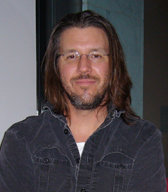David Foster Wallace

David Foster Wallace (February 21, 1962 – September 12, 2008) was an American writer and essayist of The Nineties and the 2000s.
Technically, he began writing in The Eighties; but he was in grad school at the time, so it doesn't count.
Anyway, Wallace was known for his unique brand of literature, characterized by long, rambling sentences, subtle irony, and complete incomprehensibility. His nonfiction is more accessible, but still full of epicly long sentences and footnotes.
Within literary circles, he is most famous for his second novel, Infinite Jest, which is about a videotape that is so absorbing that anyone who sees it loses interest in sleep or food and eventually dies.
His group of short stories all going by the title "Brief Interviews with Hideous Men" (four of which appear in his short story collection Brief Interviews With Hideous Men along with a bunch of other, unrelated stories) was adapted in 2008 by Jon Krasinski (aka Jim from The Office) in his first foray into directing. Unfortunately, Wallace never saw it. After a long battle with severe depression, he committed suicide by hanging on September 12, 2008, at the age of 46.
Between Dead Artists Are Better and the fact that he wrote some of the most experimental fiction of his time, Wallace will, with Jonathan Franzen, likely be remembered as the premier American Lit Fic writer of the '90s and '00s, and (most likely) of Generation X more generally (with Dave Eggers and Chuck Palahniuk coming in a distant third).
- The Broom of the System (1987, novel)
- Girl with Curious Hair (1989, short story collection)
- Signifying Rappers: Rap and Race In the Urban Present (1990, co-written by Mark Costello. A non-fiction academic book about hip-hop. It often doesn't appear on DFW's bibliography pages because it isn't that good and Wallace admitted as much. Now out of print.)
- Infinite Jest (1996, novel)
- A Supposedly Fun Thing I'll Never Do Again (1997, essay collection). The "supposedly fun thing" is a seven-night cruise in the Caribbean. After reading the essay, you will either (a) never want to ever take a cruise or (b) want to take a cruise and document exactly the kinds of suffering that DFW did.
- Incidentally, the ship he sailed on warrants an article on The Other Wiki. Make of that what you will.
- Brief Interviews with Hideous Men (1999, short story collection)
- Up, Simba! (2000, account of DFW's time as a reporter about John McCain's campaign bus during the 2000 presidential primaries)
- Everything and More: A Compact History of Infinity (2003, book-length essay)
- Oblivion: Stories (2004, short story collection)
- Consider the Lobster (2005, essay collection)
- McCain's Promise: Aboard the Straight Talk Express with John McCain and a Whole Bunch of Actual Reporters, Thinking About Hope (2008, expanded paperback edition of Up, Simba!)
- This Is Water: Some Thoughts, Delivered on a Significant Occasion, about Living a Compassionate Life (2009, book-length version of his commencement speech for Kenyon College in 2005. Released posthumously)
- The Pale King (2011, published posthumously . There's a New York Times article that explains how the published version was completed from Wallace's extensive drafts and notes)
- Fate, Time and Language" (December 2010, his undergraduate philosophy thesis)
- Doorstopper: His most famous work, the novel Infinite Jest, is over a thousand pages long. A thousand.
- Footnote Fever: His favorite technique. His footnotes frequently take up most of an entire page, especially in his nonfiction. The method apparently developed when he was writing Infinite Jest, where he needed to break up the narrative, but not too much. He chose the method of using endnotes, which developed into footnotes in his later works. The endnotes for Infinite Jest fill up over one hundred pages, the length of some novels.
- Nameless Narrative: Most of the stories in Brief Interviews With Hideous Men
- Unintentional Period Piece/Zeerust: Most of his work can be pretty definitely placed in The Nineties. Even Infinite Jest, which was supposed to take place Twenty Minutes Into the Future (probably around...well...now), manages to have this going.